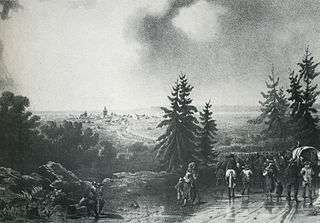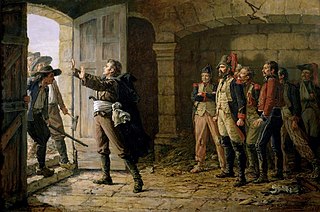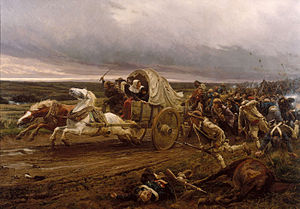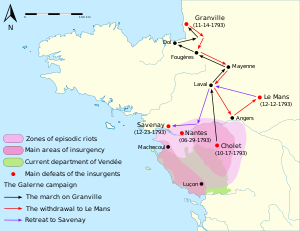
François Joseph Westermann was a French revolutionary and military leader during the French Revolution. He is best known as one of the main French Republican commanders in the initial stage of the War in the Vendée.

Generalissimo Jacques Cathelineau was a French Vendéan insurrectionist leader during the Revolution. He was known among his followers as the Saint of Anjou.

The War in the Vendée was a counter-revolution from 1793 to 1796 in the Vendée region of France during the French Revolution. The Vendée is a coastal region, located immediately south of the river Loire in western France. Initially, the revolt was similar to the 14th-century Jacquerie peasant uprising, but the Vendée quickly became counter-revolutionary and Royalist. The revolt headed by the newly formed Catholic and Royal Army was comparable to the Chouannerie, which took place in the area north of the Loire.

Henri du Vergier, comte de la Rochejaquelein was the youngest general of the Royalist Vendéan insurrection during the French Revolution. At the age of 21, he served as commander-in-chief of the Catholic and Royal Army.

The Chouannerie was a royalist uprising or counter-revolution in twelve of the western départements of France, particularly in the provinces of Brittany and Maine, against the First Republic during the French Revolution. It played out in three phases and lasted from spring 1794 to 1800. The revolt was comparable to the War in the Vendée, which took place in the Vendée region.

The Second Battle of Cholet was fought on 17 October 1793 during the French Revolutionary Wars, between French Republican forces under General Jean Léchelle and French Royalist Forces under Maurice d'Elbée. The battle was fought in the town of Cholet in the Maine-et-Loire department of France, and resulted in a Republican victory. D’Elbée was wounded and captured; he was later executed by Republican troops in Noirmoutier. The Royalist insurgent, Charles Melchior Artus de Bonchamps, was fatally wounded in the battle.
The Catholic and Royal Armies is the name given to the royalist armies in western France composed of insurgents during the war in the Vendée and the Chouannerie, who opposed the French Revolution.

The Battle of Savenay took place on 23 December 1793, and marks the end of the Virée de Galerne operational phase of the first war in the Vendée after the French Revolution. A Republican force of approximately 18,000 decisively defeated the Armée Catholique et Royale force of 6,000 at Savenay.
The Army of the West was one of the French Revolutionary Armies that was sent to fight in the War in the Vendée in western France. The army was created on 2 October 1793 by merging the Army of the Coasts of La Rochelle, the so-called Army of Mayence and part of the Army of the Coasts of Brest. In 1793 the army or its component forces fought at Second Châtillon, First Noirmoutier, La Tremblaye, Cholet, Laval, Entrames, Fougères, Granville, Dol, Angers, Le Mans and Savenay. After the main Vendean army was crushed, the revolt evolved into guerilla warfare and there were few pitched battles. In 1794 Louis Marie Turreau tried to suppress the rebellion with extremely brutal methods using the infamous infernal columns. Calmer heads finally prevailed and Turreau was recalled. On 6 January 1796, the army was absorbed into the newly formed Army of the Coasts of the Ocean. The Army of the West came into existence a second time on 17 January 1800 and was finally suppressed on 21 May 1802.
Jean Léchelle or Jean L'Échelle briefly commanded a French army during the French Revolutionary Wars. Having served in the French Royal Army as a youth, the outbreak of the French Revolution found him employed as a fencing master. He was elected to lead a volunteer National Guard battalion which fought at Valmy and Jemappes in 1792. He earned promotion to general officer after distinguishing himself at the Siege of Valenciennes and saving a representative from an angry mob. He won such favor with the politicians and the war office that he was rapidly catapulted into command of an army in the War in the Vendée. After the capable battalion leader demonstrated his total unfitness for the post of army commander, he was just as quickly arrested and thrown into prison where he died, a probable suicide.

The Battle of Le Mans was a combat in the Virée de Galerne, an operation during the War in the Vendée. It resulted in the rout of the Vendéen forces by Republican troops.

The siege of Angers was a siege of the French town of Angers on 3 December 1793 in the War in the Vendée.

The Battle of Dol was a succession of battles in the war in the Vendée. They lasted three days and two nights from 20 to 22 November 1793 around Dol-de-Bretagne, Pontorson and Antrain.
The Vendéens repelled an offensive by the Republicans against the town of Dol-de-Bretagne, then counterattacked and stormed Antrain, where the patriots' headquarters were located. The Republican forces suffered one of their heaviest defeats of the conflict and retreated to Rennes.
The Army of the Coasts of La Rochelle was an army of the French Revolution which was created on 30 April 1793 and responsible for defending a region from the mouth of the Loire River south to the Gironde. Despite its relatively short existence, the army fought numerous battles during the War in the Vendée including Thouars, Fontenay-le-Comte, Saumur, First Châtillon, Vihiers, Luçon, Chantonnay, Coron and Saint-Fulgent. Many of the battles resulted in Republican defeats at the hands of the Vendean Royalists. Of the two principal army commanders, Armand Louis de Gontaut, Duke of Biron was dismissed and later executed by guillotine while Jean Antoine Rossignol was a political appointee who was generally acknowledged to be incompetent. The army was absorbed by the Army of the West on 5 October 1793.
The First Battle of Châtillon during the War in the Vendée saw the Vendean Royalists defeat a French Republican raiding force led by François-Joseph Westermann. The rebel Catholic and Royal Army virtually destroyed the Republican column, only Westermann and a few hundred cavalrymen escaped the disaster. The Vendée revolt was a bitter civil war waged between those who supported the French Revolution and rural farmers who resented the new government's anti-Catholic laws and conscription decrees.

The battle of La Tremblaye, part of the war in the Vendée, took place near Cholet, and was a Republican victory over the Vendéens.

The battle of Laval took place on 22 October 1793, during the war in the Vendée and saw Vendéen victory over republican troops. This is the first major battle of a particular episode of the war called the Virée de Galerne.
Charles Aimé de Royrand became a Vendean leader in the War in the Vendée, a revolt against the French Revolution. He joined the French Royal Army and served in an infantry regiment during the American Revolutionary War before retiring to his estates in 1780. When the Vendean insurrection broke out in 1793 he was chosen as the leader of the southern army. He led rebel forces at Luçon, Cholet and Entrames. He was fatally wounded at Entrames on 26 October and died at Baugé-en-Anjou.

The Battle of Noirmoutier was a confrontation in the War in the Vendée which took place on 3 January 1794 between the Republicans and the Vendeans for control of the island of Noirmoutier.

The Battle of Chemillé, also referred to as the Clash of Chemillé, occurred on April 11, 1793, during the War in the Vendée. The Vendéens emerged triumphant, repelling the Republicans' assault on the town of Chemillé.

















